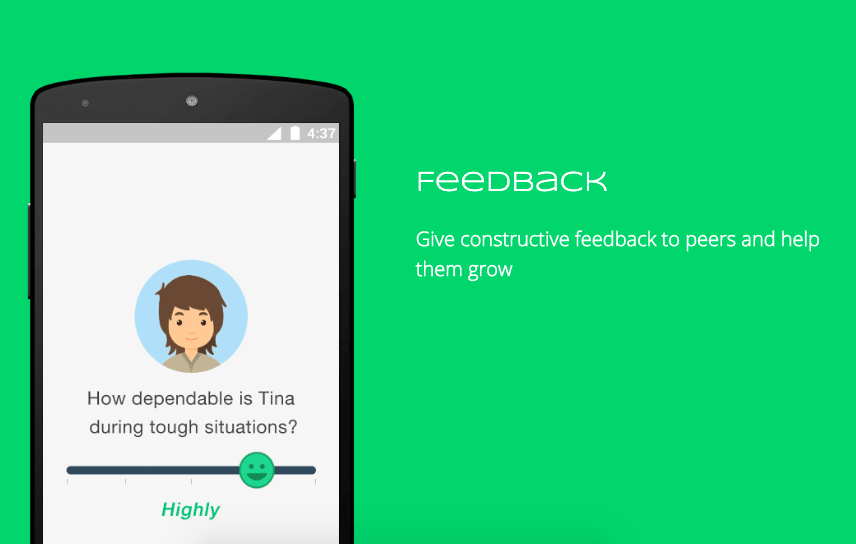A lot of corporate heated arguments, at its core, are a direct result of avoiding peaceful effective feedback sessions.
People, especially managers, often refrain themselves from giving feedback. Of course, feedback givers do not want to upset the next person. They don’t want to spoil their personal relationship.
People at the receiving end often panic at the first thought of receiving feedback. I could only imagine how fainthearted overly anxious people handle feedback sessions.
These fears are not vague.
Feedback horror stories are real.
Maybe, for this very reason, it becomes critically important for all of us to work on the art of giving & receiving “effective feedback”.
When I say “all of us”, I mean all of us, not just managers.
Effective feedback can help individuals skyrocket their performance, improve personal bonds with their peers, boost confidence, and whatnot. The ripples of this ‘effective feedback’ culture would also positively reflect on the organization’s growth curve.
Read this insight to discover the gaps/loopholes in how you give and receive feedback, and then bridge this gap with corrective measures.
Get better at WHAT you do, by tweaking the HOW.
Should we care, giving candid feedback?
Well, feedback is extremely important to keep the team thriving. The minute a team stops learning, it stops growing. Innovation takes a back seat. There is absolute stagnancy in the team. And as you would know, stagnancy stings.
To keep your team excited and confident, you must explore a few effective feedback hacks to incorporate in your org culture.
A robust effective feedback culture can spell magic for an organization, and its employees.
Without honest, constructive, and corrective feedback, it’s highly possible that an individual’s performance will tank over time. An individual might get stuck in an echo chamber of his/her own head, caught in the web of their own thoughts. The problem with echo chambers is that one doesn’t get to filter the self-bias. As a result, one may fail to identify behavioral, attitude, and technical aspects of their personality/skills which may need improvement. An absence of effective feedback could be scary. It could mean slow or even no growth at all.
Besides, to summarize, here’s why you must have an effective feedback culture in your org:
- Constructive feedback from people who have been there, done that encourages action.
- Helps to keep everyone in the team aligned.
- On-time, continuous corrective feedback helps the team avoid careless blunders.
- It helps the team build better interpersonal relationships.
- Feedback fosters a learning culture, and promotes a growth culture.
- Aids create a friendly and cordial working space.
- Feedback positively influences growth-centric business-related decisions.
- Increases confidence in the team through mutual feedback & learning.
- Helps keep biases, ego, unhealthy competition at bay, and instead facilitates in gaining healthy perspective.
Read the insight on workplace conflict resolution.
When to give effective feedback?

Before we even get into how to give feedback, it’s important to know when to give feedback. The feedback process involves emotion, strong ones. And so, the timing & delivery is critical.
You would want to maximize the positive impact of your feedback.
Of course, a majority of companies hop onto the feedback process during annual performance reviews and appraisal cycles.
But feedback is not meant to be occasional.
Would you not be freaked out and panic if you learn that your team has only got negative feedback for you, and the appraisal you were waiting for so long is going to get further delayed and you can’t do anything about it? What if you had received quarterly, monthly, or bi-weekly feedback? Wouldn’t you have taken corrective measures as soon as you learnt about your shortcomings? Wouldn’t you be growing continuously? I can hear you screaming “YESSSS”.
That’s why feedback is most effective when it’s a continuous process.
A simple feedback is meant to serve a larger purpose – growth.
Here are some of the most appropriate times when you can consider to give a feedback to your peer:
- You see the individual is doing a great work because of a particular change, you would want to appreciate that to encourage them. Never hold back an appreciative feedback.
- You are concerned about them, you have an actionable remedy available for them, and there is mutual understanding between you and your peers.
- When an individual’s behaviors aren’t aligned with the company values & culture.
- When you see the individual demonstrate capability, but shows no willingness.
- When you see the individual not incorporating earlier feedback.
- You know they are ready for feedback, and act on it. This is ideally when there is a project escalation that is spinning out of a team/individual’s control. Or, when a project is successfully completed. Who said, effective feedback is always about improvements, it is equally about appreciation.
- You sense/notice the negative effect of an individual’s activities/output or a team’s activity/outcomes.
- There is a commitment issue, productivity is going down the hills for a team, or an individual, and you have a remedy i.e., corrective feedback.
When not to give feedback?

Arghh!! Have you ever said something which was terribly timed, and you regretted it later? I’m sure you have definitely laughed at occasions where you were not supposed to. We all have done that, haven’t we? Everything has the right timing, and wrong as well. Knowing when to give feedback is smart, and knowing when not to give feedback is lit. As much as you should learn about giving effective feedback, you must also learn to repress your feedback giving urges. Good feedback at the wrong time does more harm than good.
Here are a few high-level situations where it makes sense to avoid giving feedback:
- You wish to give feedback more out of desperateness than the intent to actually help an individual/team, when the concern is trivial.
- When ego is at play, and you want to show superiority, or you wish to demonstrate your power.
- When your feedback is going to be vague, and it may demoralize someone, or make them feel pity/low. Especially when the individual is going through a tough time/project, or is highly emotional & vulnerable.
- Unknowingly, you are just giving feedback to vent out your personal frustration, and instead of facing your own failures, you are criticizing or playing the blame game with your team.
- For formality, you’re giving feedback without properly thinking it through. Someone might be perceiving you as a high authority and may take your casual feedback very seriously. Risky for them.
- When you’re giving feedback about issues over which the individual/team has no control.
- If it makes sense to give feedback, but you are unsure about delivering it the right manner, with the right tone, while maintaining your composure.
How to give effective feedback?

Now that we know the “Why” and “When”, it’s time for the “How”.
Sandwiching is a common mistake in feedback sessions. We tend to mix negative/corrective feedback between appreciative compliments. You should avoid this. Instead, be authentic. There is absolutely no need for:
“Hey Shilpa, guess what you’re doing amazing work. You’ve been exceptional on that e-commerce project.
But you know, something was not right in this edTech app that you designed. I think you’re not into it.
But hey, again, you’ve been brilliant all throughout in other projects.”
The appreciation here feels more like a lie than the truth, and may make the person doubt their good work as well. Instead, be appreciative towards the individual as and when you spot an opportunity. And keep the negative feedback isolated for specific sessions. This way, at least the recipient won’t doubt the praises, and may give more attention to the suggested corrective feedback.

Here are a few other tips to give effective feedback that does not create a sense of threat and promotes positive growth:
- Keep it personalized & exclusive
- Ask for permission from the recipient and involved stakeholders
- Make them feel safe & comfortable
- Don’t wait for the review cycle to give feedback, feedback is most effective when it is more like a continuous process.
- Empathize with the recipient, and be gentle & kind with your tone and words
- Do not beat around the bush, be precise, outcome oriented.
- Keep the process at the center
- Make sure it’s conversational, not one-direction.
- Feedback needs to be actionable.
- Follow-up, guide, help.
- Seek feedback from your peers. In fact, you can take feedback on how good your feedback giving process is.
- Don’t forget to say “Thank you”.
How to be receptive to the feedback given to you?

The fear of criticism or being told about a flaw isn’t easy nor natural for us to accept, but it’s something that we can train ourselves to embrace.
Here are a few tips that might help you in being better at receiving feedback :
- Do not panic. After all, none of us are perfect. Process feedback from an unbiased mindset, not easy though. And if it is worth incorporating, go for it, else toss it to the black hole.
- Don’t overthink or over analyze.
- If your natural reaction to feedback is getting defensive, take a minute, relax, and drop the shield. And see what’s coming. It’s not that hard a blow. It’s just feedback. Chill.
- See it as an opportunity, not a threat.
- Self awareness is pivotal, keep biases away.
- Don’t shut down. Else, peers won’t feel ease with giving honest feedback.
- Listen. Be curious and attentive.
- Take a note of important pointers being shared.
- Ask questions or doubts, seek answers.
- Justification isn’t always necessary.
- Engage to make it conversational.
- Seek guidance to reach the action points
- Discuss the progress of the feedback.
- A “Thank you” is way more important than you realize.
To sum it all up!

At Codewave, from the very beginning, we have a flat org design. This naturally solves a lot of feedback issues for us. On top of this, we have a continuous feedback culture, and it is one of the most critical pillars of our org. It does magic for us. While it isn’t easy to either give feedback or receive it, once you too realize the positive impact it can bring to you and your team, I bet it will change your mind.
Make peer feedback a culture in your teams to foster a growth first culture and to establish a highly transparent and happy work environment.
The ability to be vulnerable, to listen, to accept flaws and above all the ability to work on self to get better is such sheer bliss.
Join Codewave to experience it. Look for available positions on your LinkedIn page, or drop a resume to hello@codewave.com
Keep smiling
Frequently Asked Questions(FAQs)
1. How do you give effective feedback?
Effective feedback is specific, timely, and actionable. To give effective feedback, first make sure you understand the situation and the person’s perspective. Then, clearly and concisely state the specific behavior or action that needs improvement. Provide specific examples to support your feedback. Also, make sure to focus on the behavior and not the person. Lastly, provide suggestions for improvement and offer support to help the person implement the change. It is also helpful to give feedback in a timely manner, as it will be more effective when it is still fresh in the person’s mind and they are more likely to be able to take action on it.
2. How can an organization’s culture support the implementation of effective feedback systems?
An organization’s culture can support the implementation of effective feedback systems by promoting open communication and a growth mindset. This can be achieved by encouraging employees to give and receive feedback regularly, and by creating a safe and non-punitive environment in which feedback is viewed as a valuable tool for personal and professional development. Additionally, providing training and resources to help employees give and receive feedback effectively can help to ensure that feedback is constructive and actionable. Finally, involving employees in the design and implementation of feedback systems, and ensuring that feedback is integrated into performance evaluations and other key processes can help to ensure that feedback is seen as a critical component of the organization’s culture and operations.
3. When to avoid giving feedback to peers?
It is best to avoid giving feedback to peers when the situation is not safe or appropriate. For example, if the feedback could lead to a conflict or could be perceived as unprofessional, it may be best to wait until a later time or to address the issue with a manager or HR representative instead. Additionally, it’s important to consider the timing, context, and relationship before giving feedback to peers.
Designation : Head Designer, Codewave
Author Bio : Developer-turned UX/UI designer and Culture Alchemist at Codewave Technologies. Passionate about solving real-world problems with intuitive design and scalable solutions.







